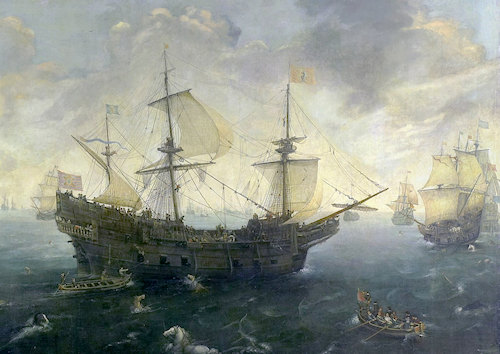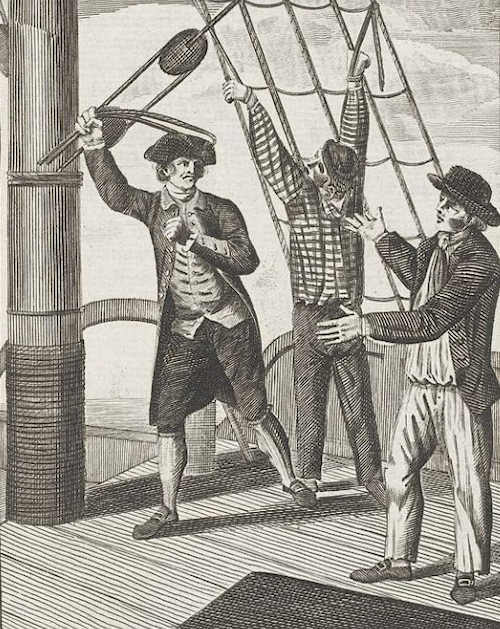Going to sea in the days of the galleons was very hard, particularly when undertaking long transoceanic sailing voyages, connecting Spain with America and the Philippines. Not only sailors, but also passengers who fled Europe for the new world, religious people who wanted to evangelize the local indigenous people or unscrupulous adventurers who enjoyed the difficult life on board. Often the three categories mixed and hid (under the guise of pious churchmen or new settlers) characters who were morally not very distant from the pirates who infested those waters.
It was the era of the great galleons
Il galleon it had been studied and developed in the XNUMXth century, heir to the maritime technological progress that had previously given rise to the caravel and then to the carrack, and became the main vessel until the first quarter of the XNUMXth century to undertake long ocean voyages. Although the paternity of its invention is attributed to the Spanish, some believe that it derived from Mediterranean and Atlantic construction traditions to replace the lighter carrack.
In the XNUMXth century all the main European powers (including the Ottoman Empire) equipped themselves with large sailing warships, which were put into crisis by the faster prisons, more manageable and well armed which in fact prevented the larger ships from being able to exploit any fire superiority.
The Atlantic and Baltic powers, having to face the large ocean waves, instead opted for the development of larger ships capable of navigating more agilely than the capacious but slow carracks, with superior armament to that of the carracks themselves. The galleon it was therefore specifically designed to undertake long ocean voyages, modifying the structures with a lower forecastle, a squared stern one and an elongated and less squat hull to obtain greater stability in the water and less wind resistance. The function of the castles was of a military nature, making possible a more efficient defense against possible boardings, being able to use light weapons that could hit the main deck from above.
 The result was a faster and more maneuverable vessel than previous ships. In the case of galleon Spanish tonnage varied between 500 and 1.200 tons depending on its length (between 40 and 60 meters). The concept of stocks in the hold was still very personal, in fact the goods were stored in bulk inside barrels (the current term tonnage derives from the term "tonneau" which means barrel, a conventional measurement which referred to the barrels used for the transport of wine, and the English measurement of 100 cubic feet, a measure of volume, was the standard measurement, which is equivalent to 2,832 cubic meters) and cases of different sizes.
The result was a faster and more maneuverable vessel than previous ships. In the case of galleon Spanish tonnage varied between 500 and 1.200 tons depending on its length (between 40 and 60 meters). The concept of stocks in the hold was still very personal, in fact the goods were stored in bulk inside barrels (the current term tonnage derives from the term "tonneau" which means barrel, a conventional measurement which referred to the barrels used for the transport of wine, and the English measurement of 100 cubic feet, a measure of volume, was the standard measurement, which is equivalent to 2,832 cubic meters) and cases of different sizes.
The biggest problem was the conservation of foodstuffs which could deteriorate rapidly being stored in this dark and poorly ventilated space, so the hold, in fact, could not accommodate passengers and crew who lived between the decks of the ship with live animals - chickens , lambs and cows – useful as fresh food reserves.
In total, a galleon weighing 550 tons, it could carry around 100 people, 60/70 of which were crew and up to 30 passengers. The crew of a galleon of the line included captains, pilots, boatswains and sailors but also cabin boys and deck boys. There were also skilled workers, carpenters, joiners, coopers and those responsible for waterproofing the hull (caulking) with oak and tar so that water did not enter. Also chaplains, butchers and surgeon-barbers. Often, when the load was paying (as for the fleet of India) there was no shortage of captains, infantrymen, and artillerymen. As mentioned, travel costs were lightened by the payments of the richest passengers, officials and merchants, often accompanied by servants and relatives, but also by adventurers seeking fortune in the new world.

The departure was preceded by a cannon shot. At the boatswains' whistles, the moorings were cast off and the sails hoisted, lifting the heavy anchors. At that moment an invocation was raised for the success of the journey: ¡Larga trinquete in name of the Holy Trinidad, Father, Hijo and Holy Spirit, three people and one true God, who is with us and we travel to safety and we carry and travel with good to our homes! ("We raise the foremast in the name of the Holy Trinity, Father, Son and Holy Spirit, three persons and one true God, who will be with us and grant us a safe journey, and will carry us and bring us back safely to our homes!" ).
Thus began the long journey marked by the ringing of the ship's bell which marked the hours and changes of watch.
The sailors carried out their tasks: washing the decks, checking the stitching of the sails, operating the bilge pumps, checking the rigging, and of course opening and closing the sails.
Normally the pilot maintained the course and the boatswain set the sails for maximum navigation efficiency. The captain did not always have nautical knowledge and therefore relied on these professional figures only giving general orders and making decisions.
At dawn the first of the two daily rations was distributed, consisting of a small jug of wine, vegetables, rice, flour, raisins, bacon, occasionally fish and salted meat, cheese and honey. Vinegar was also provided to mix with the water when it began to go bad.
"Sponge cake" was also distributed, nothing to do with the current pastry making, basically a biscuit made with coarse flour cooked twice which however tended, after the first few days, to rot and be filled with worms.

Food was prepared in a carefully guarded stove to prevent a fire from starting. Once the meal was prepared, the young cabin boys announced by singing in a loud voice: Table now, quick way, [...] who doesn't say well that I don't drink. Tabla en la buena hora; who doesn't live in a coma ("The table is set, the food is ready, [...] whoever does not say 'amen' must not receive a drink. The table is blessed; whoever does not come, must not eat."), a forerunner of the call "Mensa ready” of today.
Needless to say, captain aside, life on board was difficult for everyone, with little privacy and poor hygienic conditions. The captain, the pilot and any on-board authority ate at a separate table along with the higher-ranking members of the crew, such as the barber, surgeon, butcher, priest and bailiff. The rest of the men made do on the main deck to eat their meager rations before resuming their afternoon work.
Dinner, when it was offered, took place before sunset, so the personnel freed from the watch sought a resting place on the deck.
As night fell, after prayer, the crew looked for the best place to spread out the mats to sleep, since beds were a luxury reserved for the captain, some officers and illustrious passengers.
When not occupied with rigging the sails and daily maintenance, the sailors had few distractions: "playing, talking and reading". Whenever possible they dedicated themselves to fishing, driven above all by the need to consume some fresh food. The game, above all, was the main entertainment of the sailors even if it was officially prohibited as it was a harbinger of fights and violence.
 Discipline on XNUMXth century ships was strict and any crime or failure was punished severely, often at the discretion of the commander who had the power to "punish it at his discretion with such sanctions as he deems appropriate".
Discipline on XNUMXth century ships was strict and any crime or failure was punished severely, often at the discretion of the commander who had the power to "punish it at his discretion with such sanctions as he deems appropriate".
The human material was what it was: ex-convicts, fugitives and often adventurers seeking passage to the new world and then engaging in more profitable activities such as piracy.
In addition to flogging, a popular punishment applied to galleons was to tie the rebels to the shrouds for days, leaving them exposed to the elements without eating or resting. In the most serious cases they were hanged or thrown into the sea.
While the non-watch personnel and passengers slept, the galleon continued its journey along the route controlled by the pilot with star observation. Except in case of necessity (such as a change of direction or sail), the only daytime and nighttime activity on board was that of the men on watch. These were divided into three shifts: the first was called "de prima", followed by the one known as "de la modorra" and the third "de l'alba".
The officer of the watch went around the ship to make sure that everything was well secured and that the lookouts did not let themselves be overcome by sleep (a crime that was punished very severely). He was also made sure that the kitchen fire was put out and the bilge emptied with the pump.
When silence fell, broken only by the noise of the wind and the sea, a prayer could be heard with each rotation of the hourglass (at the time there were no on-board clocks yet): Good is what goes, / better is what comes; / one day and two deaths; / more molerá si Dios quisiere ("Good is the one that goes, / better is the one that comes; / one has passed and in two it grinds; / it will grind more if God wills."). It is said that the sailors, who were observing, had to respond with a previously agreed upon phrase to demonstrate their attention to that important function.
Unfortunately, storms, losses of crew members, shipwrecks, diseases and pirate attacks plagued the success of the navigation with a heavy toll in terms of human lives.
From the experiences transcribed in the logbooks of these indomitable sailors, many lessons were acquired which led to new technological and organizational innovations in the revolution of the maritime world in the XNUMXth and XNUMXth centuries.
In fact, the means and rules changed but not the traditions, handed down over the centuries and which are still found in the everyday life of sailors.
Photo: web
(article originally published on https://www.ocean4future.org)












